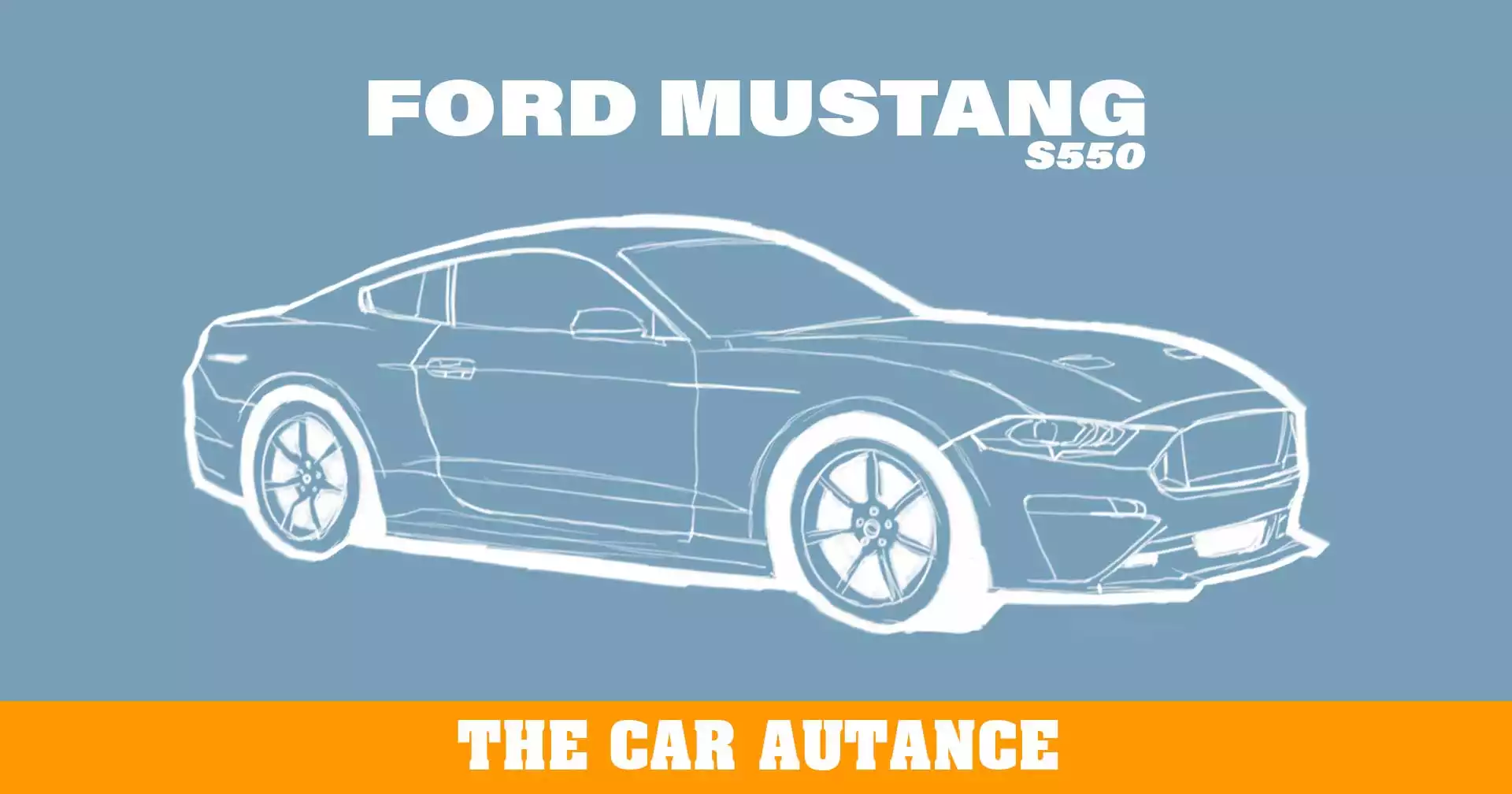Welcome to the sixth-generation Ford Mustang S550 Car Autance. As you scroll down, you’ll learn all about this vehicle’s qualities, features, finer points, and shortcomings. If you’re thinking about buying one of these, want some help maintaining or modifying one, or just want to deepen your knowledge for the next round of car trivia, you’ve come to the right place.
This is a living document that’s updated as we learn (and confirm) new valuable information. Got something to add? Drop a comment or send us an email. Don’t be shy; the more dialogue we have the better this Car Autance will get.
–Andrew P. Collins, Car Autance Editor-In-Chief
(Disclaimers, Disclosures: Some Car Autance will have links to specific forums, groups, brands, shops, or vendors for parts shopping and such. We have no sponsorship deals or official affiliation with any of them unless explicitly stated. We also explicitly state that you should work on your own car and follow our advice at your own risk.)
Contents
There’s a lot of info packed into this Autance. If you’re looking for something specific, hit command/control-F, type one of these terms, and your browser should bring you straight in.
- The Short Story
- Pictures
- Fast Facts
- Spotter’s Guide
- Rarity
- Check This Car Out If …
- Important Trim Levels and Options
- Year-To-Year Changes
- General Reliability and Ownership Costs
- Obscure Details
- Red Flags and Known Issues
- Recalls
- Where To Buy Parts
- Aftermarket Support
- Popular Modifications
- Key Technical Details
- Fluids, Filters, and Capacities
- Factory Service Manuals
- Other References and Resources
- Professional Reviews
- Owner Reviews
- What They’re Worth Now
- Where To Find One for Sale
- What To Ask A Seller
- Competitors To Consider
- Photo Galleries
- Pop-Culture References
- Enthusiast Inquiries
- Downloadable Paperback Car Autance
- Comments Disclaimer
The Short Story
The S550 generation is, as of this writing, the current Mustang. This version of the car started with the 2015 model year and is set to be replaced in 2023.
Known among enthusiasts as the most advanced Mustang ever, it came off the production line in 2015 with a host of improvements over the previous car, regardless of which engine was under the hood. Independent suspension at all four corners, variable valve timing, gasoline direct injection, and forged connecting rods inside each engine’s block were just a couple of nice evolutions for the platform. The early-2000s SVT Cobra Terminator was technically the first Mustang to get independent rear suspension, but the S550 was the first to get it across all trim levels.
As the generation progressed, suspension improvements, bumps in power, and more have been offered in different packages. This makes it truly the most flexible, do-anything Mustang platform. Want a comfy, top-down summer cruiser that gets great gas mileage? Pick up an EcoBoost convertible. Are you inclined to give Porsche Cayman GT4s (or even 911s) a run for their money on a road course? Buy a Shelby GT350R. What about something in between that’s like a modern, 1980s Fox-Body SVO with track chops? The EcoBoost High-Performance Package with EcoBoost Handling Package is a very capable and fun turbo-four track car from the factory.
Pictures
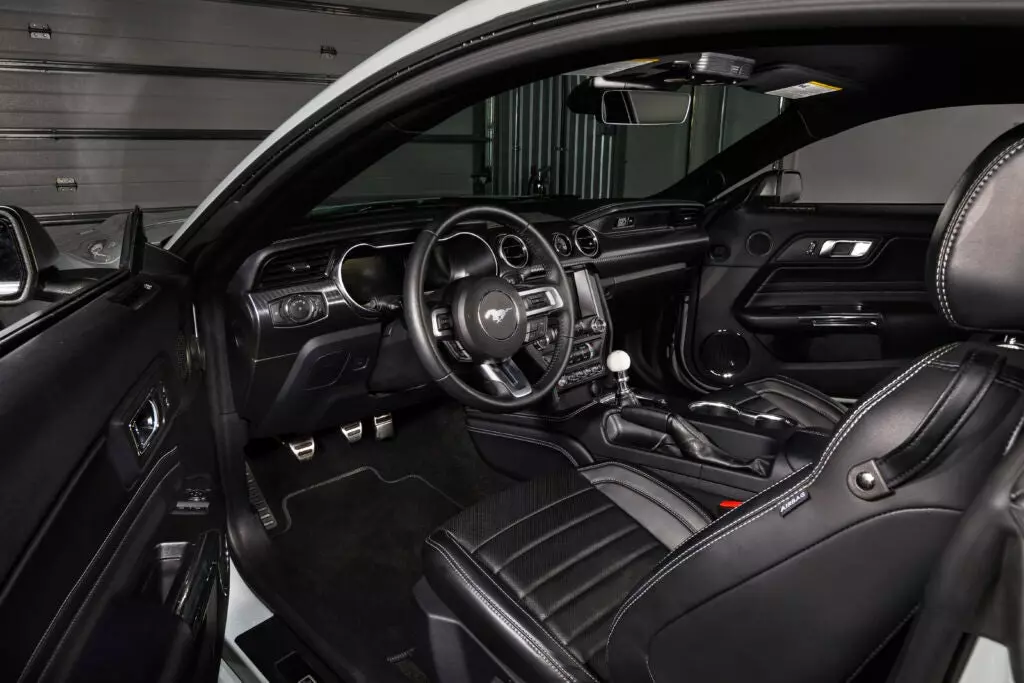
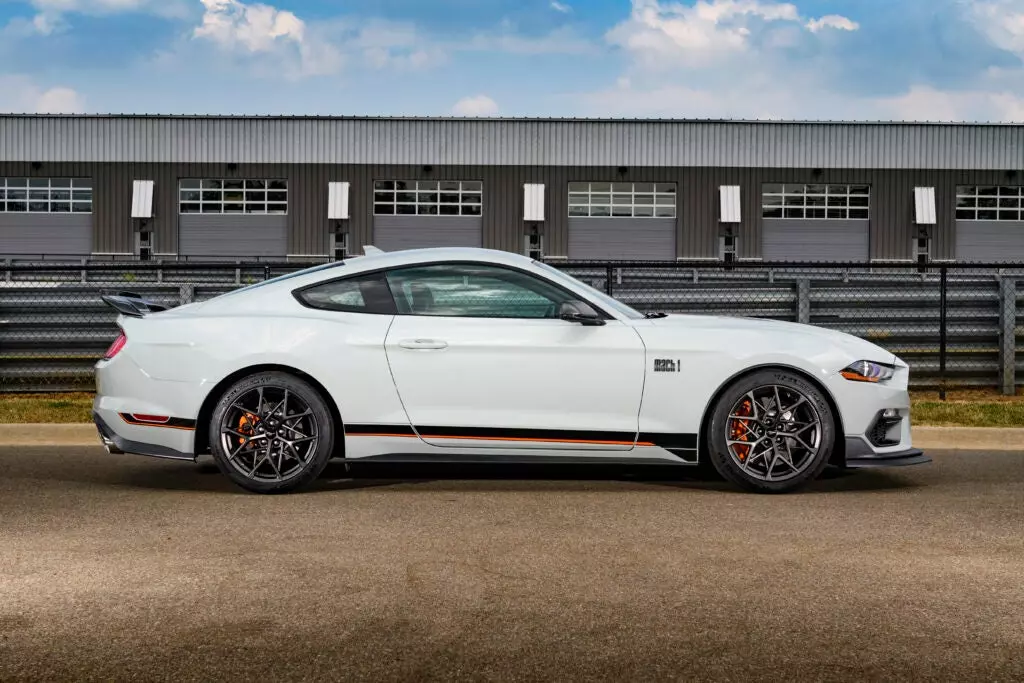


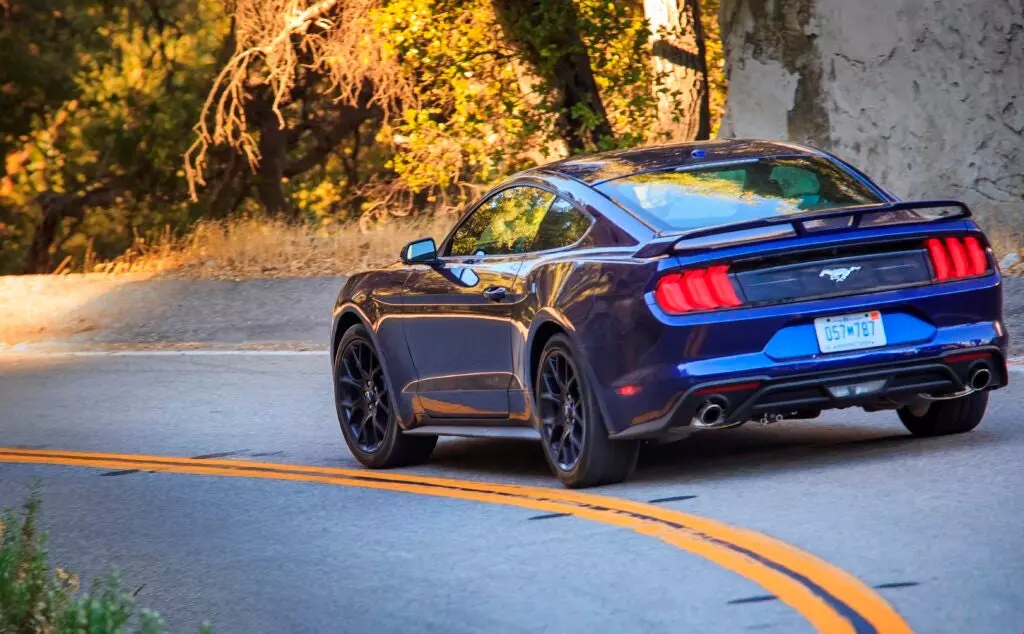

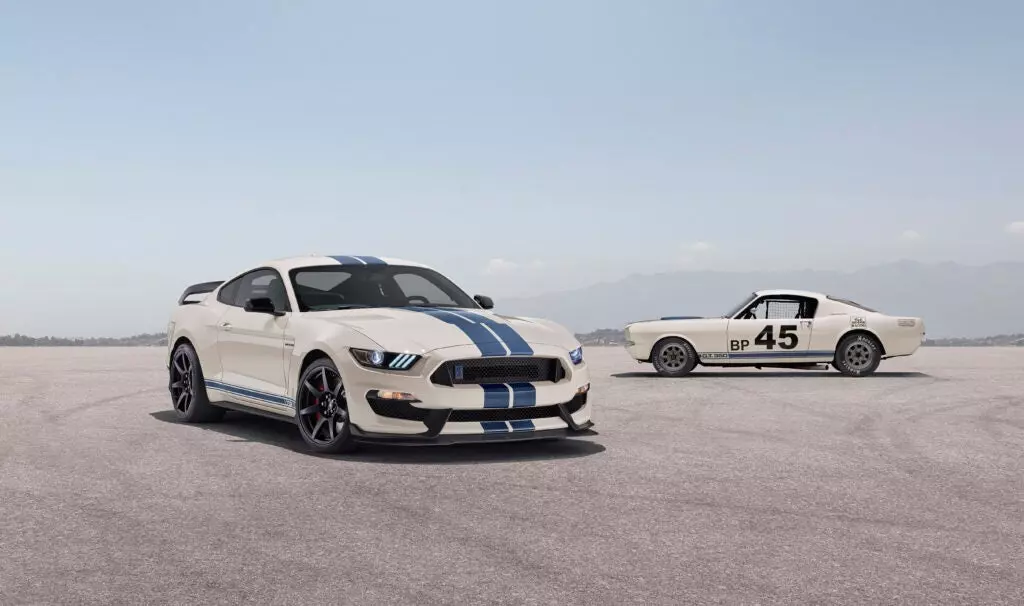
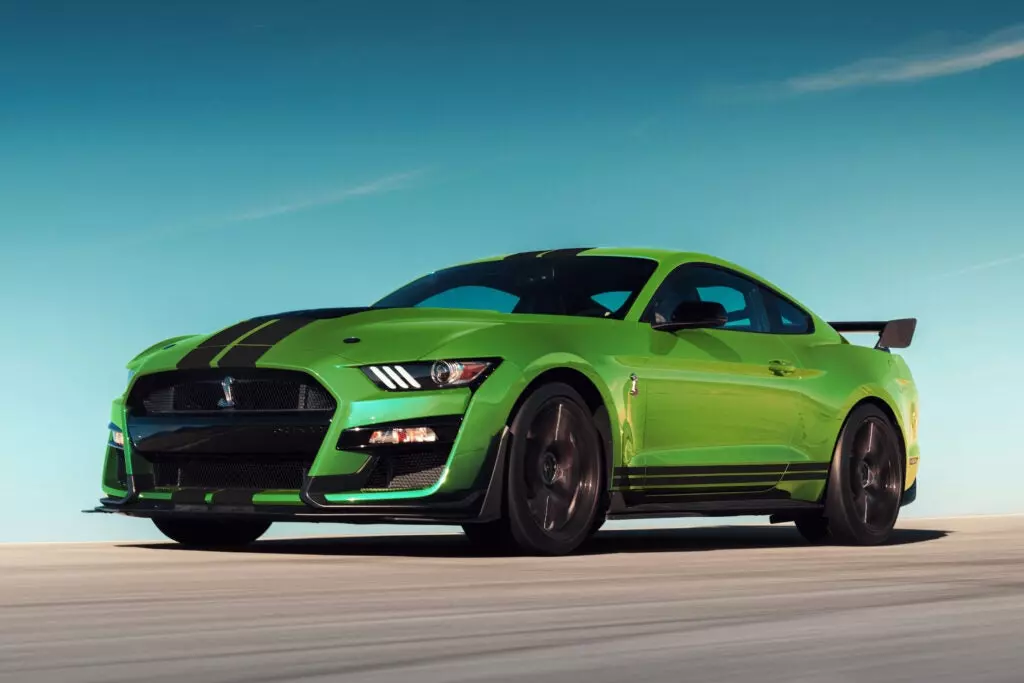
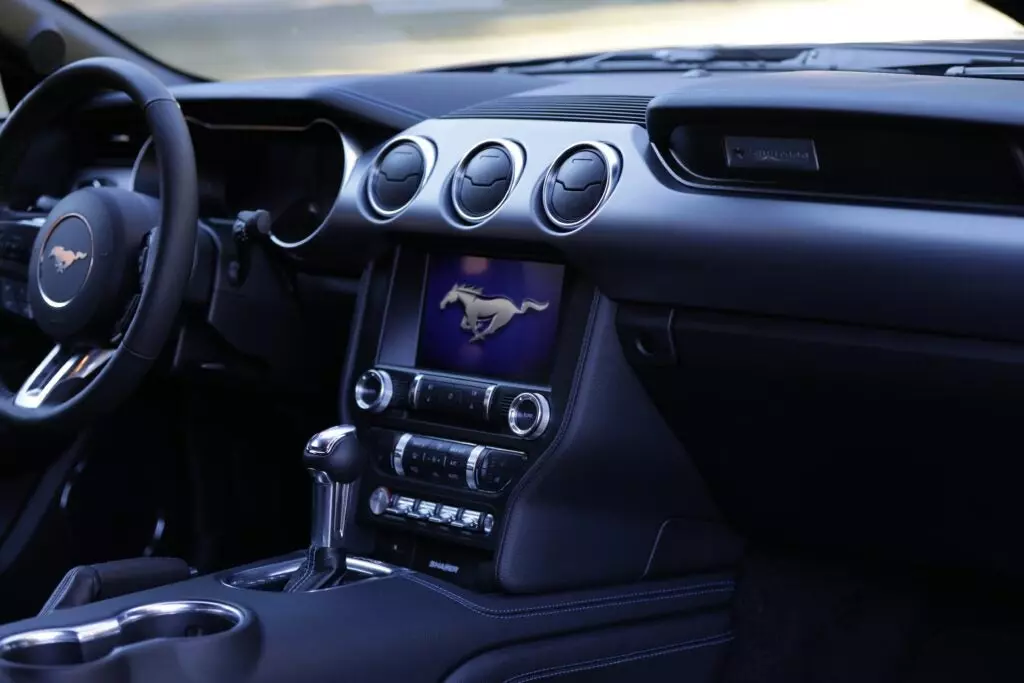
2020 Ford Mustang 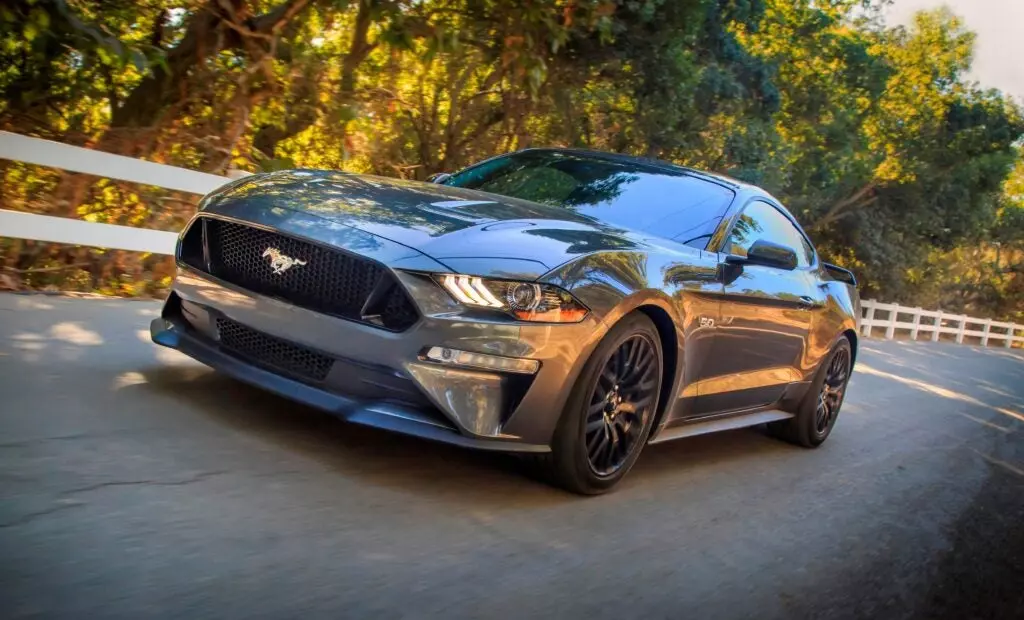
2020 Ford Mustang 
Fast Facts
- All engines produce at least 300 horsepower, including the small-but-mighty EcoBoost turbo
- This was the first Mustang to be offered in right-hand drive in any kind of significant quantity, giving buyers in the United Kingdom and beyond a more comfortable way to re-enact their “Bullitt” chase dreams
- The 5.2-liter V-8 in the Shelby GT350/R, nicknamed Voodoo, was the first American V-8 to feature a flat-plane crank from the factory, which significantly improved its high-revving characteristics
- The 2.3-liter EcoBoost makes more horsepower than naturally aspirated 3.7-liter Cyclone V-6
- There are two manual transmissions that come in stick-shift Mustangs, the Getrag MT-82 and enthusiast-coveted Tremec TR-3160
- The Shelby GT350R has clocked in a Nürburgring lap time of 7:32.19, which is faster than a Ferrari’s official time for its 458 Italia
- While it’s considering a high-compression turbocharged engine that’s optimized for premium fuel, the 2.3-liter EcoBoost can run on standard 87 octane
- The Ford Mustang Bullitt, a special homage to the legendary 1968 film of the same name, utilizes 5.2-liter Voodoo engine parts on its 5.0-liter Coyote V-8 to bump power over non-Bullitt trims
Spotter’s Guide
The S550 is arguably the best-looking modern Mustang. It’s sleek and muscular, minor appearance mods really make it pop, and it generally features classic Mustang design language. It might not be as pretty as the original, but it’s the best-looking one since. The front grille and headlights combined with its muscular rear fenders is a really nice look.
Some design accents look like other cars, too. It appears to have a sort of Hoffmeister Kink as seen on BMWs, which is ironically why people say the most recent BMW 8-series looks like a Mustang, and certain angles look more mid-2000s Aston Martin than we bet designers would be willing to admit.
Trim level is everything, however. Base EcoBoost Mustangs with lowest-tier wheels look like well-used rental cars. But the appearance upgrades with performance models make all trims look quite sharp, with performance wheels, nice front splitters, rear spoilers, simple graphics, and more.
Rarity
While it seems like S550s are everywhere, they’re actually considered one of the lowest-production Mustangs in history, even factoring in the horrendous Mustang II. In 2015, 110,648 Mustangs were produced, of which 40 percent were equipped with the Coyote V-8. A quarter came with the Cyclone V-6, and 35 percent were EcoBoost.
By contrast, 134,075 previous, fifth-gen Mustangs were produced. These both pale in comparison to 1966 when 607,568 Stangs hit the showroom floor. This is nearly 250,000 more than the number of S550s built between 2015 and 2019.
Still, during the current popularity of crossover SUVs and with the internal-combustion engine slowly being put out to pasture, Mustangs are still pretty commonplace in the performance market, enough to warrant an immense amount of aftermarket support.
Check This Car Out If …
You’re in the market for modern and fun rear-wheel-drive power and don’t want to shell out more money and potentially less reliability for European performance. Generally, the S550 is pretty darn reliable and offers a lot of bang for the buck.
They’re kind of long and bulky compared to other performance platforms, but they handle their weight and dimensions very well. In the great Ford versus Chevrolet debate, it’s certainly a solid contender against the Camaro’s many trim levels and performance options. And, to get opinionated for a quick minute: The entry-level Coyote engine is more fun than an entry-level Chevy LT1.
Important Trim Levels and Options
As mentioned earlier, the S550 is a versatile performance platform.
In addition to having a variety of available engines, they can also come equipped with performance packages that improve their suspension, brakes, and tires. These are identified as the GT Performance Package, EcoBoost Performance Package, and so on. From 2018 on, all models could be equipped with adaptive dampers as well, which changes the game as far as having a Mustang that can go from comfy highway cruiser to tightened-up track beast with the push of a button.
The 2019-2020 Bullitt is an homage to the 1968 Mustang GT Fastback featured in the 1968 film it shares a name with. Its third-generation Coyote engine features a 20-hp bump thanks to some intake parts from the Voodoo and has several very nice visual upgrades. These include Dark Highland Green paint or irreverent black paint plus special wheels and badging. It also comes without a spoiler, has nice interior upgrades, and has a limited-production number plaque. Think of it as a well-equipped GT with a little more power and beautiful paint.
Then, the Shelby GT350, GT350R, and GT500, and 2021 Mach 1 are all in a league of their own. Each is a hardcore, high-horsepower monster, with the Voodoo engine under the hood of the 350s and the supercharged Predator engine under the 500. The Predator puts out an impressive 760 horsepower. These also feature big, upgraded brakes, track-centric drivetrain gearing, adaptive MagneRide dampers, improved cooling, slick bodywork, lighter wheels, and very sticky, track-friendly summer tires.
The Mach 1 is a fitting tribute to the original, with a sum of parts that’s a sort of greatest hits album. It’s engine is a tuned Coyote similar to that in the Bullitt, but it features all the braking, gearbox, and suspension goodies found in the GT350/R and GT500.
Year-to-Year Changes
The S550 has undergone a lot of minor and significant changes since it debuted in 2015. CJ Pony Parts, an aftermarket parts retailer for the Stang and other Fords, has a comprehensive list of what all of these changes are. The most important to point out, however, are various engine updates and revisions.
The second-generation Coyote V-8 is technically a revision of the previous Mustang generation’s 5.0-liter Road Runner V-8. It features bigger valves, multiport fuel injection, the ability to rev higher, variable intake timing, and more. It was in 2015-2017 Mustangs and produces 435 horsepower and 400 pound-feet of torque.
The third-generation Coyote featured a few lessons learned from the Voodoo V-8 and was bolted up under the hood of the 2018-and-newer Mustang GT and Bullitt. It features a higher compression ratio, a stronger block, multi-port and direct injection (the best of both worlds, really), and some other small changes here and there that amounted to a bump up to 460 horsepower, 420 pound-feet of torque, and an 8,000 rpm redline. The only downside is it requires premium fuel, whereas the previous generation ran just fine on regular-octane unleaded.
Both the Voodoo and Predator engines remained fairly unchanged throughout their runs.
The four-cylinder EcoBoost received some fun upgrades of its own. In 2020, Ford introduced the EcoBoost High Performance Package. In addition to some cool badging, selectable drive modes, reworked suspension, Mustang GT brakes, and a track-centric final drive ratio, the engine got a larger turbocharger, revised valves, bigger radiator, and some other heavier-duty hardware. This amounted to 332 horsepower and 350 pound-feet of torque, which is a 23-hp increase. Plus, according to enthusiasts, these improvements open the taps for aftermarket power gains.
General Reliability and Ownership Cost
Because the Mustang is made in the United States and is an honest-to-goodness muscle/pony car, part costs are fairly cheap compared to its competition from European. The one area where maintenance starts to cost more money is in consumables. Oil capacity on all of the Mustang’s engines is pretty high. Wheels are bigger, so tires are bigger and more expensive. OEM tires on performance-centric trims such as Shelbys are expensive summer or near-DOT track tires, as are brake pads, and both wear much faster than conventional tires and pads.
Obscure Details
- The S550 received a five-star safety rating from the NHTSA when it debuted in 2015. Feels good to drive around in a fast, rear-wheel-drive car that’s also safe.
- The EcoBoost engine is called the Valencia because it’s built in Valencia, Spain. In the same vein as Ford’s Windsor V-8 that was made in Windsor, Canada.
- The Ford Mustang’s turn signal sounds similar to a horse’s clippity-clop galloping sound
- Mustang GTs come standard with electronic line-lock, which enable brake stand (burnouts) to warm up the tires at the drag strips or lay down some nice, straight 11s when Johnny Law isn’t watching
- Randy Pobst drove the EcoBoost HPP w/EHP for MotorTrend and set a 1:34.57 at Willow Springs International Raceway, faster than he was able to do in a Bentley Continental GT-3 R, and two seconds off his lap time in an F80 BMW M3.
- The rear turn signals on S550 are sequential, which is a nice throwback to Mustangs of the 1960s.
- EcoBoost HPP-equipped Mustangs have special, throwback-looking badging, however, it’s not a throwback to the Fox-Body SVO.
- The engine start/stop button in an S550 flashes at 30 beats per minute, which is the resting heartbeat of an average adult horse-version of a Mustang.
- Mustangs have a small, nondescript sunglasses holder on the dash left of the steering wheel.
- On later, Ford Sync3 infotainment system-equipped S550s, the navigation system will automatically pull up local gas stations when the fuel level gets low.
Red Flags and Known Issues
From our research, it seems like there’s a lot of hot air around reliability with the S550. Sure, there are some issues from the factory as well as plenty of technical service bulletins and warranty issues, but on the whole, we’d say they’re pretty stout cars. As long as they’re taken care of and not irresponsibly beaten on. Just as with any car, track work should include shortened maintenance schedules and improved cooling.
Leaky rear windows and doors. Due to their design, the rear windows and doors are known to leak water.
Wonky HVAC systems. Owners have reported issues with the S550’s heat and air conditioning, from the heat being stuck on high to the air conditioning prematurely dying.
Voodoo engine oil consumption and low oil pressure. Owners have complained about this, but it doesn’t seem very widespread. Enthusiasts seem to agree that it depends on whether the engine was broken in properly or the oil was changed regularly enough. Also, it’s not uncommon for high-performance, high-compression engines to naturally consume a little oil.
Carbon buildup in EcoBoost engines. As with most turbocharged, direct-injection engines, this isn’t necessarily a problem, but proper maintenance should be factored in. We’ve discussed this issue in previous posts.
Head gasket issues. Early EcoBoost engines had a mixup at the factory and sometimes came equipped with the wrong head gasket-type, causing premature failure.
EcoBoost overheating issues. Because they’re high-boost turbo motors, they produce a lot of heat. It’s recommended that EcoBoost Mustangs that’ll see regular track work have upgraded radiators and oil coolers.
Recalls
There have been quite a few recalls and technical service bulletins for the S550 Mustang since it debuted, but rest assured, a lot of it isn’t major stuff. CJ Pony Parts compiled a huge, easy-to-navigate list.
Pop your VIN into the NHTSA’s lookup tool and you should be able to figure out what, if any, recalls your Mustang might be facing.
Where to Buy Parts
What’s nice about Mustangs is they’re a beloved, made-in-the-U.S. platform, so parts can be found anywhere and in good quantity. Any brick-and-mortar location should be well-stocked with normal maintenance items, otherwise online sources such as AutoHausAZ, CJ Pony Parts, and buying directly from Ford will keep you well covered.
Aftermarket Support
The S550 might be the aftermarket tuning enthusiast’s dream RWD platform. There’s an endless number of suspension, power, braking, and exterior modifications available. Many aftermarket parts retailers offer fun stuff for the S550, especially legendary Mustang tuners Roush, Steeda, and Saleen.
Popular Modifications
Due to its massive aftermarket, there’s something in the S550 for everybody. Turbo kits, supercharger kits, high-end three-way adjustable coilovers, cool body kits, lots of wheel choices — the sky is the limit.
Key Technical Details
Engines:
3.7-liter Cyclone DOHC V-6: 305 horsepower, 285 pound-feet of torque
2.3-liter EcoBoost DOHC inline-4: 310 horsepower, 320 pound-feet of torque
5.0-liter second-gen Coyote DOHC V-8: 435 horsepower, 400 pound-feet of torque
5.2-liter Voodoo DOHC V-8: 526 horsepower, 429 pound-feet of torque
5.0-liter third-gen Coyote DOHC V-8: 460 horsepower, 420 pound-feet of torque
5.2-liter Predator supercharged DOHC V-8: 760 horsepower, 625 pound-feet of torque
Transmissions:
Six-speed automatic 6R80 (2015-2017)
10-speed automatic 10R80 (2018 and newer)
Six-speed manual Getrag MT82 (2015-2017)
Six-speed manual Getrag MT82-D4 (2018 and newer)
Six-speed manual Tremec TR-3160
Drivetrain: Rear-wheel Drive
Suspension: double-ball-joint independent front, integral-link independent rear, optional adaptive MagneRide dampers
Wheelbase: 107.1 inches
Overall length: 188.3 inches
Curb weight: 3,520-3,800 pounds
OEM tire sizes:
There are many OEM tires sizes. CJ Pony Parts has a very useful resource that covers them all. Note: The optional tire sizes are upgraded/performance package sizes.
Fluids, Filters, and Capacities
Fuels:
87 octane: Coyote Gen. II, Cyclone, and EcoBoost
91 octane: Coyote Gen. III, GT350/R, GT500, EcoBoost High-Performance Package
Battery size: 590CCA
Engine oils:
Cyclone: Six quarts of 5W-20 full synthetic, changed every 5,000-10,000 miles
EcoBoost: Six quarts of 5W-30 full synthetic, changed every 5,000-10,000 miles
Second-generation Coyote: Eight quarts of 5W-30 full synthetic, changed every 5,000-10,000 miles
Third-generation Coyote: 10 quarts of 5W-20 full synthetic, changed every 5,000-10,000 miles
Vooooo: 10 quarts of 5W-50 full synthetic, changed every 5,000 miles, 3,000 miles if tracked
Predator: 11.5 quarts of 5W-50 full synthetic, changed every 5,000 miles, 3,000 if tracked
Oil filters:
Cyclone and Coyote: Ford Motorcraft FL-500S/AA5Z-6714-A, change with oil
EcoBoost: Ford BE8Z-6731-AB, change with oil
2015-2017 Voodoo: Ford Motorcraft GR3Z-6731-A, change with oil
2018 and newer Voodoo: Ford Racing CM-6731-FL1A, change with oil
Predator: Ford Motorcraft FL-2087, change with oil
Air filters:
Models/packages equipped with a conventional airbox: Ford Motorcraft FA1918, change every 15,000-30,000 miles (depending on weather and climate)
Models/packages equipped with a cone filter: Ford Motorcraft FA1922, change every 15,000-30,000 miles (depending on weather and climate)
Cabin air filter: Ford Ford FP78, replace every 50,000 miles
Automatic Transmission Fluid: Ford Motorcraft Mercon V ATF, 13 quarts, change every 75,000 miles
Manual transmission oil: Ford Motorcraft Premium Hypoid Gear Lubricant XY-75W85-QL, 5.5 pints, change every 75,000 miles
Transmission filter: Ford Motorcraft BL3Z7A098A, change with fluid
Differential oil: Motorcraft Premium Hypoid Gear Lubricant, P/N XY-75W85-QL, 1.6-2.5 quarts, change with transmission fluid/oil; enthusiasts also recommend 3.25-4.25 of friction modifier, depending on capacity
Coolant: Ford Motorcraft VC-7DIL-B Gold Pre-Diluted Antifreeze/Coolant, as much as 3.5 gallons depending on engine, change every 50,000 miles
Power Steering Fluid: N/A
Brake fluid: Enthusiasts recommend 750 ml of a quality, DOT5 brake fluid, such as Motul RT600 or Castrol SRF, change every 15,000-45,000 miles, fewer if tracking regularly
Clutch fluid: Gets changed with brake fluid
Spark plugs: Replace all every 36,000-48,000 miles, the former if tracking regularly
EcoBoost: Four Ford Motorcraft S-P537
Cyclone: Six Ford Motorcraft SP-520
Coyote (all generations): Eight Ford Motorcraft SP-519K
Voodoo: Eight Ford Motorcraft SP-519K
Predator: Eight Ford Motorcraft SP-519K
Fuel filter: Ford Motorcraft Fuel Filter FG-1083, replace every 50,000 miles
Factory Service Manuals
As of this writing, an enthusiast uploaded the full, comprehensive 2016 model-year factory service manual to Google Docs. It can be found here. As with any unknown file download, we advise a virus scan before opening.
Otherwise, hard copies of all model years’ various manuals can be found on eBay, direct from Ford, as well as in compact disc form from various websites via a simple Google search.
Other References and Resources
There are several Facebook groups dedicated to the S550 Mustang, though remember: Just as with all Facebook owners groups, researching for pertinent information can be tedious.
There’s an active forum that’s specifically for running S550s on the track.
Professional Reviews
Erik Johnson had great things to say about the GT350 Heritage Edition for MotorTrend in October 2020:
“The GT350’s handling remains sublime, and the communication from its tires to your fingertips gloriously direct. On warm rubber, the car knifes toward apexes with alacrity, and the intensity of the signals sent through the steering wheel shocks your hair on end like the world’s most wicked Van de Graaff generator. The six-speed manual’s throws can be long and overly stiff, but those are the only issues with the primary controls, which offer precise responses only matched—and exceeded, if you can believe it—by those of the stonking, 760-hp GT500.”
Emme Hall really enjoyed the Bullitt when she reviewed it for CNET Roadshow in August 2020:
“The whole package just works. Coupled with the limited-slip diff, the independent rear suspension means the Bullitt can happily slalom through tight curves. Sure, at 3,850 pounds it’s not exactly what I’d call spry, but the direct steering helps, as do the sticky Pilot Sport 4S tires. You can even get the Bullitt with Ford’s magnetic ride suspension — a $1,695 option — which can adjust the dampers up to 1,000 times per second.”
“A few different drive modes really let you dial in the ride. I’ll leave Snow alone for obvious reasons and say the Bullitt is best experienced in Sport. Each mode switches up the traction control and throttle response, and I can personalize the steering effort between Comfort, Normal, and Sport settings. An individual My Mode lets you set the parameters to your specific liking, so I can have the performance set to Sport but the exhaust set to Track because I like annoying my neighbors. Of course, there’s also Line Lock for sweet smoky burnouts.”
Yours truly had a blast with the EcoBoost HPP w/EHP when I reviewed it for WindingRoad.com in Fall 2020:
“There is a stigma of owning a four-cylinder Mustang. No, it’s not as loud and aggressive, and it makes significantly less power (though we’re wondering what kind of power increases one can achieve in the aftermarket). It’s also rental-car spec, which takes up a huge slice of the stigma pie, for sure. But if a consumer doesn’t care, is happy with a low-to-mid-five-second zero-to-60-mph time, wants significantly better fuel economy, digs on the idea of an angry baritone engine note with whistly turbo exclamations, and some significant handling and steering benefits, they really can’t go wrong.”
“Because of its economy, sharp handling, good driver aids, and even good ground clearance, we’d call it a good all-rounder. If a consumer is on the taller or wider side, however, and needs a decent-sized rear seat, maybe save it for a weekend/track beast only, or see how other seats feel. It’ll surely get better track mileage than its significantly-thirstier V-8 siblings.”
Owner Reviews
Stay tuned. We’ll have one in here soon.
Own or owned one of these and want to share your thoughts? Hit up in the comments or email [email protected].
What They’re Worth Now
Prices vary a bit due to new examples still being sold as new, and the current bizarre used-car market we’re experiencing in 2021. Here’s an idea of what pricing is like through conventional dealership channels on the used market. Expect to pay a few thousand dollars less for private-party sales.
The prime example: A Shelby GT350 with as much as 20,000 miles (which seems to be the highest mileage in the state of California) starts at $60,000. The cheapest GT500 Shelbys start around $95,000. Well-equipped, very-low-mileage EcoBoost and GT trims start around $35,000-$40,000.
A very clean driver: A 2018 and newer, well-equipped EcoBoost with 30,000-70,000 miles seems to start around $27,000, with GTs going for around $23,000-$25,000 with fewer options.
An honest car: $19,000 appears to be the floor for a base-spec EcoBoost or V-6 model, with 75,000-125,000 miles in good condition. GTs start around $5,000 more in similar condition.
Where to Find One for Sale
Since the S550 generation is so recent, there’s a near-endless supply of new and lightly used examples available through conventional dealership lots, including certified pre-owned.
Enthusiast groups are a good source for clean, well-cared-for runners, as well as various online auction sites.
Craigslist and Facebook Marketplace have a decent number of listings, but as always, do your due diligence.
What to Ask a Seller
Besides basic used-car inspection protocol, here are some questions you might want to ask when looking at a late-model Mustang for sale.
• Has all applicable warranty work been done, and have all technical service bulletins been fulfilled?
• Has the car been tracked?
• Does the engine consume any oil? If so, how much between oil changes?
• Have any aftermarket parts been added?
• Has the car ever been in any fender benders?
• Has there been any water intrusion into the cabin?
• How’s the HVAC system?
Competitors to Consider
The Mustang’s biggest competitor is the Chevy Camaro and its many trims. The 1LE-package, track-centric models fetch a little less than the Shelbys on the used market, but on the whole, it comes down to if you’re a part of the bow-tie brigade or a Blue Oval lover. Both are great cars. It all comes down to personal preference.
From Europe, sporty rear-wheel-drive enthusiast platforms such as the BMW M235i, M2, and M3 stack up with the GT and Shelby trims, and the Shelby GT350R and GT500 are much cheaper alternatives to sports cars such as the Porsche Cayman GT4 and 911.
EcoBoost models equipped with handling and performance packages should be considered by those inclined to go with a turbocharged, FWD hot hatch or Camaro 1LE turbo four-cylinder. Sure, the Honda Civic Type R is an awesome car, but it can’t powerslide.
Photo Galleries
Good ol’ FavCars.com has plenty of S550 photos, as does Ford’s media site.
Pop Culture References
The S550 has made an appearance outside of the motoring press from time to time but has never really had a starring role, as demonstrated by IMCDB.org.
Actress Emma Roberts drives an S550 convertible, and Jay Leno owns a 2020 GT350R. Besides those two, celebrities seem to prefer older galloping horses.
Enthusiast Inquiries
If we find folks asking the same question over and over again, we’ll include that (and an answer) in this section here.
Downloadable Paperback Car Autance (Coming Soon)
If you’re old school and like to keep reference notes on paper, or you’re just a completionist and want a free accessory for your Mustang, you’ll be able to download and print out a Paperback Car Autance soon.
Think of it like an owner’s manual supplement. Keep it in your car and your days of waiting for slow internet on your phone at the auto parts store are over.
Comments Disclaimer
You’ve reached the end of the sixth-generation Ford Mustang S550 Car Autance and are about to scroll into the comment section. If any questions were left unanswered in the text above, try posing it in the space below. Related tips are also welcome. Thanks for reading.
